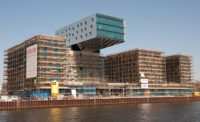The building, designed by a team led by the Miller Hull Partnership LLC, has put the Bullitt Foundation on the global sustainability map. “Bullitt Center has already had a phenomenal impact on the way people think about the urban built environment,” says Bullitt board member, Frank Greer, a founder of communications firm GMMB.
The building is the first and tallest spec office building to be certified as a Living Building under the rigorous Living Building Challenge (LBC) developed by the International Living Future Institute (ILFI)—a Bullitt grantee and tenant. “Bullitt Center could not have been done without Denis,” says Jason McLennan, ILFI’s founder and CEO.
Among other things, Hayes persuaded Seattle city officials to support the building project by creating several programs, which he helped craft, that cleared regulatory and other impediments. One is the Living Building Pilot Program. “Denis is able to make environmental investments ‘win-wins’ for the environment and for business, says Jorge Carrasco, who retired as general manager of the electric utility, Seattle City Light, in May.
There was some debate over whether it was possible to design a net-zero-annual-energy-use building in the cloudiest city in the lower 48 states. “I grew excited about using this opportunity to create a building whose very existence would stretch what people thought of as doable,” says Hayes, of his venture into development with a purpose.
His first coup was to convince Bullitt’s board to risk nearly one third of the foundation’s $100-million endowment on the groundbreaking venture. “I was one of the naysayers on the board but ended up being one of Denis’ most ardent supporters,” says Harriet Bullitt, the 90-year-old daughter of the late Dorothy Bullitt, who formed the conservation group in 1952 to safeguard Pacific Northwest ecosystems.
Powers of Persuasion
Hayes has had 46 years of experience honing his powers of persuasion. One of his early organizing successes was coordinating the first Earth Day on April 22, 1970, an event that drew 20 million in cities across the U.S.
The celebration, the brainchild of the late Sen. Gaylord Nelson (D-Wisc.), is considered the birth of the modern environmental movement. Within the next few years, Congress passed, by wide margins, such landmark measures as the Clean Air Act, the Clean Water Act, the Endangered Species Act and the Resource Conservation and Recovery Act.
“There is no question” that Denis Hayes’ leadership and Earth Day caused an upheaval in public attitude and triggered significant pro-environment congressional action, says former U.S. Rep. Pete McCloskey (R-Calif.), Nelson’s co-chair for the first Earth Day. “He did a hell of a job” turning anti-war activists into environmental activists.”
In the fall of 1969, at the behest of Nelson, Hayes dropped out of a joint program at the Kennedy School and Harvard Law School to join the cause. But instead of the environmental cleanup college teach-ins Nelson envisioned, Hayes united disparate conservation groups under one umbrella to give them more political clout, renamed the event Earth Day and moved it from campuses to city squares.
“Denis was way ahead of the curve with the first Earth Day, and that vision is even more important now in light of climate change,” says Ron Judkoff, chief architectural engineer of the National Renewable Energy Laboratory (NREL) in Golden, Colo.










Post a comment to this article
Report Abusive Comment